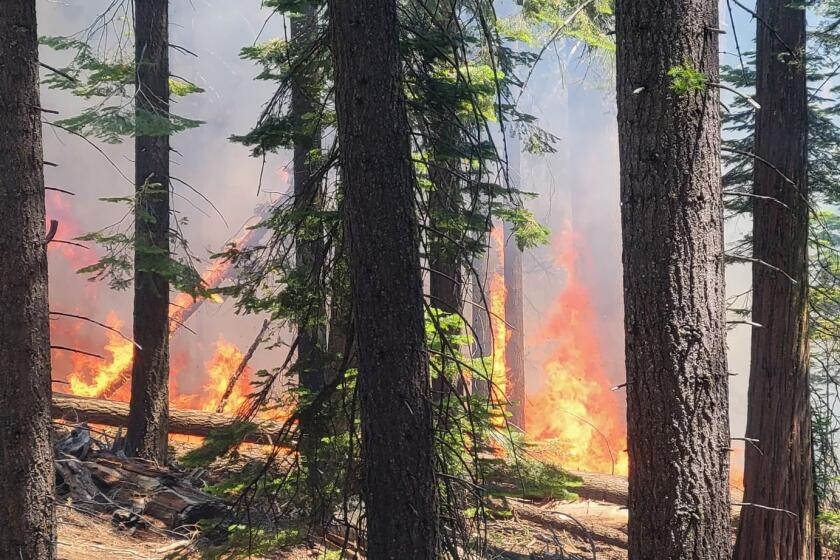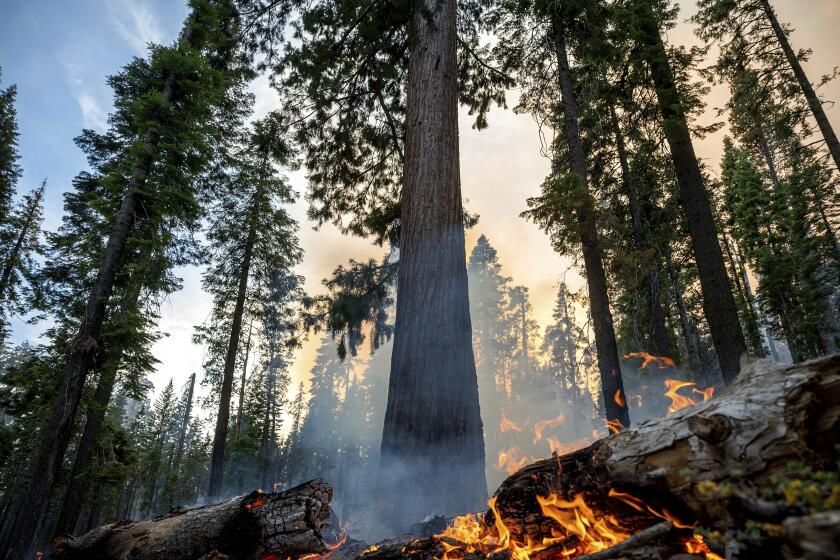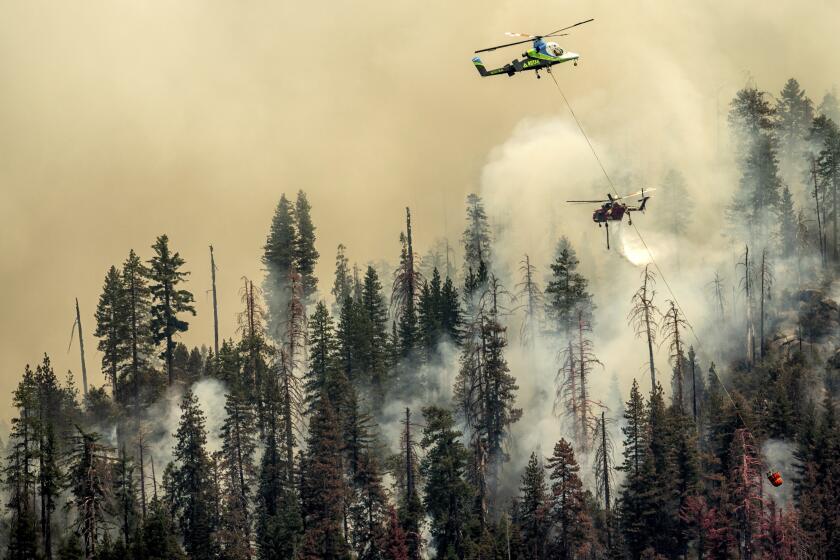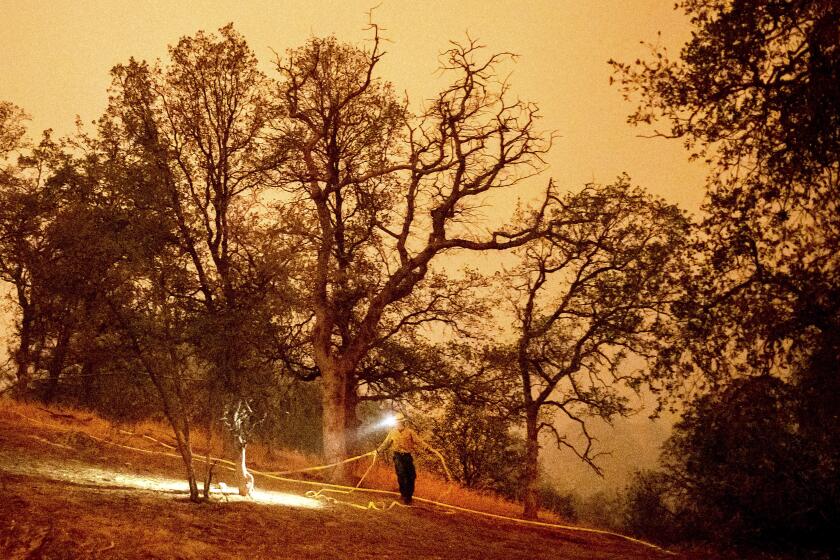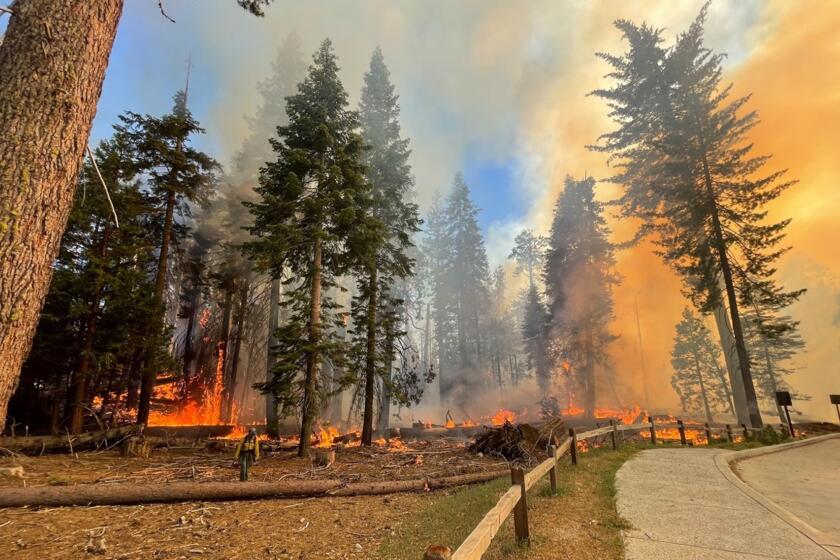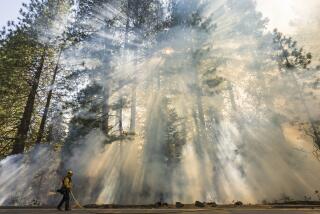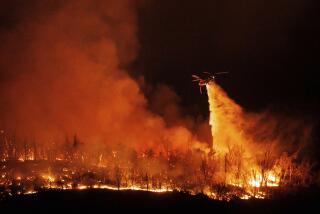Firefighters race to defend ancient sequoias from 2,700-acre Washburn fire in Yosemite
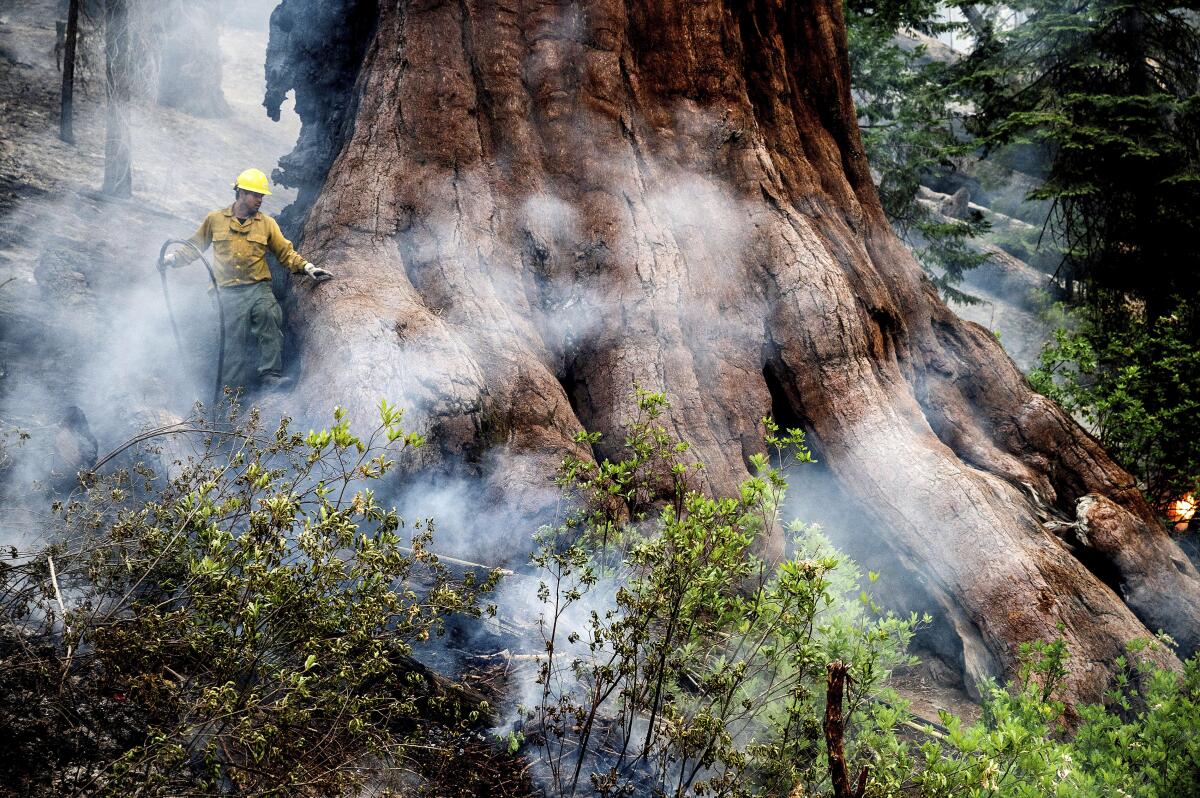
Firefighters waged an all-out battle Monday as the 2,720-acre Washburn fire burned at the edges of Yosemite National Park‘s largest grove of ancient sequoia trees.
The fire, which more than doubled in size over the weekend, was within striking distance of the park’s Mariposa Grove, home to more than 500 mature sequoias including the Grizzly Giant, a 209-foot behemoth estimated to be about 3,000 years old.
“We really don’t want to leave this one to chance, because this really is such an iconic tree,” forest ecologist Garrett Dickman said in a video update showing sprinklers spraying water around the base of the Grizzly Giant.
“We’re trying to give it some preventative first aid, really, and make sure that when the fire — if the fire — comes over here, that this tree is protected,” he said. “That is, to cool flames and to increase the relative humidity and decrease the fire behavior around this tree.”
Sequoias are known to withstand heat, and in fact have long relied on fire for reproduction. But California’s new breed of hotter, faster and more frequent fires fueled by climate change have proven a formidable foe for the giants, with last year’s KNP Complex and Windy fires destroying about 3,600 of the trees in Sequoia National Forest and Sequoia and Kings Canyon National Parks — an estimated 3% to 5% of the world’s sequoia population.
The year prior, the Castle fire in Sequoia National Park wiped out an estimated 10% of the world’s sequoias, with experts warning that extreme heat and drought were sapping moisture from the trees and impairing their defenses.
Matt Ahearn, an operations section chief with California Interagency Incident Management Team 13, said the fire was skirting the edge of the Mariposa Grove.
“It has backed a little ways into that, but it hasn’t backed intensely into the grove,” Ahearn said during a Monday night community meeting about the fire. “We have people going in there, cleaning around the bases of the trees, eliminating the residual heat and so forth.”
Authorities don’t believe the fire will encroach further, but crews are keeping an eye on whether the blaze starts moving to the east and south, a development that could encircle the grove, he said.
The Washburn fire in Yosemite National Park was threatening some 500 giant sequoias, along with the community of Wawona.
Crews had their work cut out for them. Not long after officials declared 25% containment on the blaze, images captured by wildfire cameras showed an explosion of activity Monday afternoon, including a massive pyrocumulus cloud over the fire, signaling intense heat.
“We don’t want to say everything’s fine and we’re getting a good handle on this fire and it’s downhill from here on out, because all it’s going to take is one hour of wind,” said Stanley Bercovitz, a spokesman with the U.S. Forest Service.
Officials downgraded containment to 22% Monday night.
The blaze, which ignited Thursday near the park’s Washburn trail, was feeding on “heavy dead and down fuels,” according to the Forest Service, including vegetation dried by the West’s worsening drought.
“They’re dealing with complicated terrain, and there’s not a lot of natural barriers we can use — things like lakes and roads that the fire won’t cross,” Bercovitz said.
The Mariposa Grove, Wawona, and the Wawona Hotel and campgrounds are closed due to the Washburn fire. Conditions are smoky.
The fire was also threatening the community of Wawona, where mandatory evacuation orders remained in place and Highway 41 was closed from the South Entrance to Henness Ridge Road.
But while structure defense remained a top priority for firefighters, Bercovitz said he was getting inquiries from around the world from people worried about the sequoias.
“The acreage is low but the panic level is high just because of the trees,” he said. “I just got a call from Hawaii, from someone who said, ‘I couldn’t sleep last night because I was so worried about the trees.’”
Yosemite National Park Superintendent Cicely Muldoon said there were close to 700 personnel assigned to the blaze as of Monday night.
“We’re attacking it in every possible way: a lot of aircraft, a lot of hand line, a lot of back burning,” Muldoon said.
Because of the natural role fire plays in Yosemite’s wilderness ecosystem, officials often manage forest fires in the park rather than immediately extinguishing them.
But with the Washburn fire threatening Wawona and the Mariposa Grove, crews are taking an all-out suppression approach that includes using bulldozers to create a barrier around the community, Yosemite fire information spokesperson Nancy Phillipe said over the weekend.
Firefighters were also spraying down trees, scraping the ground to bare mineral soil and taking other measures rolled out in recent years as wildfires burned thousands of giant sequoias.
The KNP Complex last year led to one of the most indelible images from the 2021 fire season: the massive General Sherman tree wrapped in protective foil.
Crews battling the Washburn fire had not yet turned to foil to defend the Grizzly Giant, but Marc Peebles, a spokesman for the Washburn fire’s incident management team, said they had wrapped some “high-risk trees” in the park with the fire-suppressive wrap.
“They have containment lines in [the grove], and it’s been plumbed with fire hoses, and fire engines are in there mopping up and taking care of hotspots,” Peebles said.
The Washburn fire had grown to at least 2,044 acres and was burning near historic Mariposa Grove, home to about 500 giant sequoias, officials said.
Indeed, firefighters were using a variety of tactics to fight the blaze, including “offensive firing,” or the process of using intentional fire to stop the spread of uncontrolled flames.
The offensive backfires were allowing crews to introduce low-intensity fire to the area and eliminate crown fires, or fires near the tops of the trees, Ahearn said.
Officials similarly hoped that a history of fire management in the national park would help slow the spread. According to Bercovitz, that history includes prescribed fire and mastication with heavy machinery to help thin out vegetation that can act as fuel for flames.
The 8,940-acre KNP Complex fire is within striking distance of Sequoia National Park’s Giant Forest, home to the largest tree on Earth, officials said.
But while crews were not expecting to see strong wind at the fire on Monday, they were contending with increased heat and reduced relative humidity. Temperatures near the fire climbed into the low 90s on Monday with humidity hovering around 20%, according to the National Weather Service.
Weather service meteorologist Andy Bollenbacher said there may be a slight midweek reprieve before the heat picks back up on Friday and into the weekend, but cautioned that any relief would be minimal.
“It’ll go from being extremely hot to being really hot,” he said. “It’s going to start cooking again by Friday, Saturday.”
The fire has created large plumes visible from miles away, and Bollenbacher said smoke was affecting Yosemite Valley as well as portions of the Sacramento Valley and the Bay Area.
“The smoke is going west, northwest of the fire — that whole area is being polluted quite a bit,” he said.
Crews scramble to protect giant sequoias in Yosemite’s Mariposa Grove as the Washburn fire burns 1,190 acres in the national park.
The plume was so intense that on Saturday, a tree branch was “sent into the air from the powerful updraft produced by the fire,” the Forest Service said, and “as it dropped back to earth, it narrowly missed two firefighting aircraft.”
One Twitter user captured an audio recording of the pilot communicating with a dispatcher after the incident.
“Just wanted to let you know a branch went right over the top of us — pretty good size, probably 50 feet above us coming down, and fell right in between Tanker 103 and myself,” the pilot can be heard saying.
During Monday’s community meeting, an Oakhurst resident asked authorities whether the fire’s cause has been determined.
Muldoon said a specific cause isn’t known, but she seemed to rule out natural causes.
“As you all know, there was no lightning on that day, so it’s a human-start fire and it’s under investigation,” she said. “That’s all I can really say.”
Times staff writer Gregory Yee contributed to this report.
More to Read
Sign up for Essential California
The most important California stories and recommendations in your inbox every morning.
You may occasionally receive promotional content from the Los Angeles Times.
